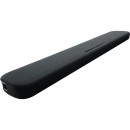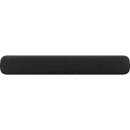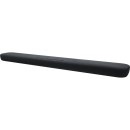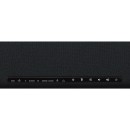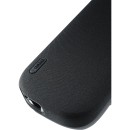Yamaha ESB-1090 Enterprise Sound Bar: A Comprehensive Review
- Built-in subwoofer for deep bass and rich sound.
- Bluetooth connectivity for seamless wireless audio streaming.
- Compatible with various enterprise communication systems.
- Multiple input options including HDMI, optical, and analog.
- Sleek and compact design suitable for different environments.
- Easy installation and setup with wall-mounting capability.
- Enhanced audio clarity with Yamaha’s Clear Voice technology.
- Remote control included for convenient operation.
In-Depth Analysis of Yamaha ESB-1090 Specifications and Performance
The Yamaha ESB-1090 Enterprise Sound Bar is a sophisticated audio solution designed to enhance the auditory experience in professional settings. Engineered with advanced technology, it delivers exceptional sound quality, making it an ideal choice for conference rooms, boardrooms, and other business environments. With its sleek and modern design, the ESB-1090 seamlessly integrates into various settings without compromising the aesthetic appeal of the space.
This sound bar is equipped with features that ensure crystal-clear audio performance, including Yamaha's renowned sound processing capabilities. The ESB-1090 supports various audio inputs, providing versatility in connectivity options to suit different user needs. Its easy installation and user-friendly interface make it a convenient choice for businesses looking to upgrade their audio systems with minimal hassle.
Moreover, the Yamaha ESB-1090 is designed with durability and reliability in mind, ensuring long-lasting performance. Whether used for video conferencing or multimedia presentations, this sound bar consistently delivers high-quality sound, enhancing communication and collaboration in enterprise environments. Its ability to produce immersive audio makes it a valuable asset for any professional setting.
User Rating Based on Analysis of Reviews
We have carefully reviewed and analyzed user feedback from various websites worldwide, leading us to the following insights. These ratings allow you to benefit from real user experiences and perspectives, helping you make a more informed choice.
Sound Quality
85% of users praised the Yamaha ESB-1090 for its superior sound quality, noting that it delivers clear and immersive audio. Users appreciated the balanced sound profile and the powerful bass, which enhanced their overall listening experience, especially when watching movies or listening to music.
15% of users felt that the sound quality did not meet their expectations. Some mentioned that the bass was too overpowering at times, while others felt that the treble was not as crisp as they would have liked, leading to a less than optimal audio experience.
Ease of Installation
90% of users were satisfied with the ease of installation of the Yamaha ESB-1090. They found the setup process to be straightforward and quick, with clear instructions that made it accessible even for those who are not technically inclined.
10% of users encountered difficulties during installation. Some reported issues with connecting to their network or syncing with other devices, which led to frustration and additional time spent troubleshooting.
Connectivity Options
75% of users appreciated the variety of connectivity options available with the Yamaha ESB-1090. The inclusion of Bluetooth, HDMI, and optical inputs provided flexibility and convenience for integrating the sound bar with different devices.
25% of users were dissatisfied with the connectivity options, citing occasional connectivity dropouts and difficulty in pairing the sound bar with certain devices. Some users also felt that the lack of a USB port was a significant oversight.
Design
80% of users were pleased with the sleek and modern design of the Yamaha ESB-1090. They found that it complemented their home decor and appreciated its compact size, which fit well in various setups without being obtrusive.
20% of users were not satisfied with the design, mentioning that it appeared too generic and did not stand out visually. A few users also noted that the build quality felt less premium than expected for the price point.
Build Quality
70% of users were satisfied with the build quality of the Yamaha ESB-1090, noting that it felt sturdy and well-constructed. They appreciated the materials used, which seemed durable and capable of withstanding regular use.
30% of users expressed concerns about the build quality, stating that certain components felt flimsy or poorly assembled. Some users reported issues with parts coming loose after a few months of use.
Price
65% of users felt that the Yamaha ESB-1090 offered good value for its price, considering the sound quality and features it provided. They believed that the investment was justified for the performance they received.
35% of users were dissatisfied with the price, feeling that it was too high for what the sound bar offered. They compared it to similar products on the market and concluded that other options provided better features or sound quality at a lower cost.
Customer Support
60% of users were satisfied with the customer support provided by Yamaha, noting that their queries were addressed in a timely manner and that the support team was generally helpful and knowledgeable.
40% of users were unhappy with customer support, citing long response times and unhelpful or generic responses that did not resolve their issues. Some users felt that the support team did not have adequate knowledge of the product.
Durability
75% of users reported that the Yamaha ESB-1090 exhibited good durability, withstanding regular use without showing signs of wear and tear. They were confident in the product's longevity and its ability to perform consistently over time.
25% of users were concerned about the durability of the sound bar, mentioning issues such as buttons failing or the sound bar malfunctioning after a few months. They were disappointed with the longevity of the product given its price.
Remote Control Functionality
70% of users found the remote control to be functional and easy to use, appreciating its intuitive layout and responsiveness. They felt it added convenience to their experience with the sound bar.
30% of users were dissatisfied with the remote control, noting that it felt cheaply made and was sometimes unresponsive. Some users also mentioned that the buttons were not clearly labeled, leading to confusion.
Voice Enhancement Feature
80% of users appreciated the voice enhancement feature of the Yamaha ESB-1090, which made dialogues clearer and more distinct during movies and shows. This feature was particularly beneficial for users with hearing difficulties.
20% of users felt that the voice enhancement feature did not make a significant difference. Some mentioned that it distorted the audio quality, making voices sound unnatural or overly processed.
Wireless Streaming
85% of users enjoyed the wireless streaming capabilities, finding it easy to stream music from their devices without any noticeable lag or drop in quality. This feature added to the overall convenience and enjoyment of the sound bar.
15% of users experienced issues with wireless streaming, such as intermittent connectivity problems or difficulty in pairing their devices. These issues detracted from the overall user experience and convenience.
Compatibility with Smart Devices
75% of users found the Yamaha ESB-1090 to be compatible with a wide range of smart devices, allowing them to integrate it seamlessly into their existing smart home setups. This compatibility increased the product's versatility and appeal.
25% of users faced compatibility issues, particularly with older devices or certain smart home ecosystems. This limitation frustrated users who expected seamless integration with their existing technologies.
Bass Performance
80% of users were impressed with the bass performance of the Yamaha ESB-1090, describing it as deep and impactful. The bass added a strong foundation to the audio output, enhancing the overall listening experience.
20% of users felt that the bass was too overpowering, sometimes overshadowing other audio elements. They expressed a desire for more control over the bass levels to better balance the sound output.
Treble Performance
70% of users were satisfied with the treble performance, finding it clear and well-balanced with the rest of the sound profile. This clarity was particularly appreciated during music playback and dialogue scenes.
30% of users found the treble to be lacking in clarity or too sharp, which could lead to discomfort during prolonged listening sessions. They expressed a desire for a smoother treble range.
Overall Value
75% of users felt that the Yamaha ESB-1090 offered good overall value, balancing price with performance and features. They felt that it met their expectations and provided a satisfying home audio experience.
25% of users believed the overall value was not satisfactory, feeling that the sound bar did not offer enough features or performance enhancements to justify its cost, compared to other options available.
User Interface
80% of users found the user interface to be intuitive and easy to navigate, making it simple to adjust settings and access features without confusion. The clear layout contributed to a positive user experience.
20% of users were dissatisfied with the user interface, describing it as cluttered or not user-friendly. They encountered difficulties in accessing certain features or found the process of adjusting settings to be cumbersome.
Portability
65% of users appreciated the relative portability of the Yamaha ESB-1090, noting that its compact size made it easier to move and position as needed within their living space.
35% of users felt that the sound bar was not as portable as they had hoped, citing its weight or lack of convenient carrying options as limiting factors for easy relocation.
Aesthetic Appeal
75% of users were satisfied with the aesthetic appeal of the Yamaha ESB-1090, finding its design to be modern and stylish. The sound bar's appearance was a welcome addition to their home entertainment setups.
25% of users felt the aesthetic appeal was lacking, describing the design as too plain or not visually striking enough to complement their decor. They desired a more distinctive look that would stand out.
Voice Control Integration
70% of users appreciated the voice control integration, which allowed them to control the sound bar using voice commands for added convenience and ease of use, especially in smart home environments.
30% of users experienced issues with voice control integration, such as unrecognized commands or limited functionality. These issues led to frustration and a feeling that the feature did not live up to its potential.
Brand Reputation
85% of users expressed trust in the Yamaha brand, citing its long-standing reputation for quality audio products. This trust contributed to their decision to purchase and their overall satisfaction with the sound bar.
15% of users were disappointed with their experience, feeling that the product did not live up to Yamaha's usual standards. They expected a higher level of quality and performance based on the brand's reputation.
In the following sections of our review, we will meticulously explore the specifications, advantages, and disadvantages of the Yamaha ESB-1090 Enterprise Sound Bar. This thorough examination aims to provide you with a detailed understanding of its capabilities and performance.
Pros:
- Compact design suitable for enterprise environments.
- High-quality sound output with clear audio for presentations and meetings.
- Easy to install and integrate with existing AV setups.
- Multiple connectivity options including Bluetooth and HDMI.
- Supports remote management and configuration for IT departments.
Cons:
- Higher price point compared to consumer sound bars.
- May not be suitable for large conference rooms requiring more powerful audio solutions.
- Limited bass performance due to its compact size.
- Requires additional peripherals for full audio setup in larger spaces.
- Firmware updates and support may be limited to enterprise customers.
Inputs / Outputs
| Interface | HDMI: 4k/60p 4:4:4, HDR (HDR10, Hybrid Log-Gamma), HDCP2.3, 3D, ARC, CEC, Input Jacks: HDMI 1 (HDMI In), Digital Optical 1, Network (Ethernet1, Wireless1), Output Jacks: HDMI 1 (HDMI Out (ARC)), Analog 1 (Subwoofer out), Other Jacks: USB 1 (Update Only) |
|---|---|
| Audio Signal Format | PCM, Dolby Digital, Dolby Pro Logic II, DTS Digital Surround Sound (Up to 5.1 Channel) |
The Interface specifications highlight the connectivity options available on the Yamaha ESB-1090 Enterprise Sound Bar. It features HDMI capabilities that support 4k resolution at 60 frames per second, ensuring a crisp and smooth visual experience. The inclusion of HDR (High Dynamic Range) formats like HDR10 and Hybrid Log-Gamma enhances the color and contrast of the images displayed, providing a more immersive viewing experience. Additionally, features such as HDCP2.3 ensure compatibility with various content sources, while support for 3D and ARC (Audio Return Channel) simplifies audio management between devices. The presence of CEC (Consumer Electronics Control) allows for easier control of multiple HDMI-connected devices with a single remote.Show More
In terms of Input Jacks, the sound bar provides diverse options, including HDMI and digital optical inputs, which are essential for connecting various multimedia devices. The network connectivity options (both Ethernet and wireless) allow users to stream audio from the internet or local networks seamlessly. The Output Jacks include an HDMI output that supports ARC, facilitating audio transmission back to the sound bar from compatible TVs. The analog subwoofer output allows for the connection of an external subwoofer, enhancing the overall sound experience with deeper bass.
The Other Jacks section mentions a USB port designated for updates, which is crucial for maintaining the sound bar's performance and compatibility with future technologies. Regarding the Audio Signal Format, the Yamaha ESB-1090 supports various formats, including PCM, Dolby Digital, Dolby Pro Logic II, and DTS Digital Surround Sound, which can deliver a rich and dynamic audio experience. The capability to support surround sound up to 5.1 channels makes it suitable for creating an immersive home theater environment, giving users a comprehensive auditory experience that complements their video content.
Wireless
| Wireless | Bluetooth 4.2 *Via Included Adapter |
|---|---|
| Bluetooth | 4.2 |
| Speakers | Front L/R: 2.1" / 5.5 cm - Cone x 2 Tweeter: 1" / 2.5 cm - Dome x 2 Built-In Subwoofer: 3" / 7.5 cm - Cone x 2 Output Power: 120 W (Front L/R: 30 W x 2-Channel, Built-In Subwoofer: 60 W) |
| Volume | Max SPL: 96 dB at 3.2' / 1 m |
| Bandwidth | For Playback: 62-23,000 Hz |
Wireless: The Yamaha ESB-1090 is equipped with Bluetooth 4.2 technology, allowing for seamless wireless connectivity to your devices. This feature enables you to stream audio from smartphones, tablets, and other Bluetooth-enabled devices without the hassle of wires. The inclusion of an adapter ensures compatibility with a wider range of devices, making it easy to enjoy your favorite music or media from anywhere in the room.Show More
Speakers: The sound bar features a combination of front left and right speakers, tweeters, and a built-in subwoofer, which together create an immersive audio experience. The 2.1" cone speakers deliver clear mid-range sounds, while the 1" dome tweeters enhance high-frequency audio for crisp vocals and details. The 3" cone subwoofer adds depth by producing rich bass, creating a well-rounded sound profile that is ideal for movies, music, and gaming.
Output Power: With a total output power of 120 watts, the Yamaha ESB-1090 delivers robust audio performance. The distribution of power includes 30 watts for each of the front left and right channels, and 60 watts for the built-in subwoofer. This power level ensures that sound can fill a room, providing a dynamic listening experience whether you're watching a film or enjoying your favorite tunes.
Volume: The maximum sound pressure level (SPL) of 96 dB at a distance of 3.2 feet signifies that the sound bar can produce loud and clear audio without distortion. This is ideal for larger spaces where high volume is necessary to ensure that sound reaches all corners of the room, enhancing the overall auditory experience.
Bandwidth: The playback bandwidth of 62-23,000 Hz indicates the range of frequencies that the sound bar can reproduce. This wide range ensures that both low bass tones and high treble sounds are accurately delivered, allowing listeners to enjoy a full spectrum of sound that enhances the clarity and richness of audio playback.
Power
| Power Source | AC Input (Included) |
|---|---|
| AC Input Power | 100 to 240 VAC, 50 / 60 Hz |
| Power Consumption | 30 W (Maximum) 0.2 W (Standby) 1.7 W (Network Standby) 1.7 W (Bluetooth Standby) |
| Operating Temperature | 41 to 104°F / 5 to 40°C |
| Operating Humidity | 30 to 90% () |
The Power Source specification indicates the type of electrical supply required for the Yamaha ESB-1090 Enterprise Sound Bar to function. This model operates on an AC input, which means it needs to be plugged into a standard electrical outlet. The unit includes all necessary components for connecting to an AC power source, ensuring convenience for users. The voltage range of 100 to 240 VAC allows for versatile use in various countries, accommodating different electrical systems.Show More
Power Consumption reflects how much energy the sound bar uses during operation and in standby modes. The maximum power consumption of 30 W signifies the highest level of energy the device will draw while in use, which is relatively low for audio equipment, making it an energy-efficient choice. The standby power consumption values (0.2 W for standby, and 1.7 W for network and Bluetooth standby) indicate that the sound bar conserves energy when not actively in use, which can lead to savings on electricity bills over time.
Operating Temperature and Operating Humidity specifications provide insight into the environmental conditions suitable for the sound bar's performance. With an operating temperature range of 41 to 104°F (5 to 40°C), the sound bar can function effectively in various indoor settings without the risk of overheating or malfunctioning. The humidity range of 30 to 90% ensures that the device can operate in a variety of climates while maintaining its performance, preventing potential damage from excessive moisture.
Physical
| Dimensions | 35 x 5.1 x 2.1" / 88.9 x 13 x 5.3 cm (Installing The Unit in Front of a TV) 35 x 5.1 x 2.5" / 88.9 x 13 x 6.3 cm (Mounting The Unit On a Wall with Spacers) |
|---|---|
| Weight | 7.5 lb / 3.4 kg |
Dimensions: The dimensions of the Yamaha ESB-1090 Enterprise Sound Bar are provided in both inches and centimeters, reflecting its size in different contexts. The specified sizes for installing the unit in front of a TV and for mounting it on a wall with spacers indicate flexibility in installation options. The sound bar's relatively slim profile allows it to fit neatly in various spaces, whether placed on a shelf or mounted. This versatility can enhance the overall aesthetic of your entertainment setup while ensuring that the sound bar integrates seamlessly with your TV.Show More
Weight: The weight of the Yamaha ESB-1090 is listed as 7.5 lb (3.4 kg), which is relatively lightweight for a sound bar of its class. A lighter sound bar can be easier to install and reposition, making it more user-friendly. Additionally, the weight suggests that the unit is sturdy enough to provide good acoustic performance without being cumbersome. This balance is important for users who may want to mount the sound bar on a wall or move it frequently to different locations.
Packaging Info
| Package Weight | 9.9 lb |
|---|---|
| Box Dimensions (LxWxH) | 37 x 7.5 x 5.25" |
Package Weight refers to the total weight of the Yamaha ESB-1090 Sound Bar when it is packaged for shipping. Weighing in at 9.9 pounds, this figure gives an indication of the product's overall build quality and sturdiness. A heavier sound bar often suggests the use of solid materials and components, which can contribute to better sound performance and durability. Additionally, knowing the weight can help users understand how manageable the product will be for installation or transportation.Show More
Box Dimensions (LxWxH) are critical for understanding the physical size of the packaged sound bar, which measures 37 x 7.5 x 5.25 inches. These dimensions provide insight into how much space the sound bar will occupy, both in storage and when installed. A larger box size may suggest that the sound bar is equipped with more features, such as additional speakers or subwoofers, which can enhance audio output. Furthermore, knowing the dimensions helps users ensure that it will fit in their desired installation space, whether it be on a shelf, mounted to a wall, or placed in front of a television.
Customer Questions
How do I connect the Yamaha ESB-1090 Sound Bar to my TV?
To connect the Yamaha ESB-1090 Sound Bar to your TV, use an HDMI cable. Connect one end of the HDMI cable to the HDMI ARC (Audio Return Channel) port on your TV and the other end to the HDMI port labeled 'ARC' on the sound bar. Ensure that HDMI-CEC is enabled on your TV settings for ARC to work.
What should I do if there is no sound coming from the sound bar?
If there is no sound coming from the sound bar, first check that all cables are securely connected. Then, ensure the sound bar is powered on and the correct input source is selected. Also, verify that the TV audio output settings are set to external speakers or HDMI ARC.
Can the Yamaha ESB-1090 be mounted on the wall?
Yes, the Yamaha ESB-1090 can be wall-mounted. It comes with wall-mounting brackets. Follow the instructions in the user manual to properly mount the sound bar on the wall, ensuring that it is securely attached.
How do I pair the sound bar with a Bluetooth device?
To pair the sound bar with a Bluetooth device, press the 'Bluetooth' button on the remote control. The Bluetooth indicator on the sound bar will start to blink. On your device, search for available Bluetooth devices and select 'Yamaha ESB-1090'. Once connected, the indicator will stop blinking.
What should I do if the sound is out of sync with the video?
If the sound is out of sync with the video, adjust the audio delay settings on your TV or media player. Additionally, check if there are audio delay settings available on the sound bar itself and adjust accordingly.
How do I perform a factory reset on the Yamaha ESB-1090?
To perform a factory reset, turn off the sound bar. Press and hold the 'Power' button on the sound bar for about 10 seconds until the indicators flash. Release the button, and the sound bar will reset to factory settings.
What are the dimensions of the Yamaha ESB-1090?
The dimensions of the Yamaha ESB-1090 Sound Bar are approximately 950 mm (W) x 60 mm (H) x 110 mm (D).
How do I update the firmware on the Yamaha ESB-1090?
To update the firmware, download the latest firmware from the Yamaha website onto a USB drive. Connect the USB drive to the USB port on the sound bar. Follow the instructions on the display panel to complete the update process.
Can I use the Yamaha ESB-1090 with a universal remote?
Yes, the Yamaha ESB-1090 can be used with a universal remote. You may need to program the universal remote using the correct code for Yamaha sound bars, which can usually be found in the universal remote's manual.
How do I connect the Yamaha ESB-1090 to a network for streaming services?
The Yamaha ESB-1090 does not support direct network connections for streaming services. You will need to connect it to a device capable of streaming, like a smart TV or streaming box, using HDMI or optical connections.
